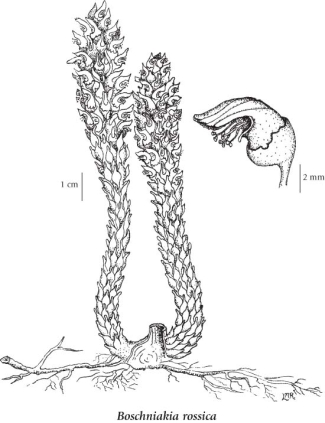Boschniakia rossica (Cham. & Schltdl.) Fedtsch.
northern groundcone
Orobanchaceae (Broom-rape family)
Introduction to Vascular Plants
northern groundcone
Orobanchaceae (Broom-rape family)
Introduction to Vascular Plants
Species Information
General:
Parasitic herb from a coarse fleshy root and thickened stem base; stems single or clustered, short glandular-hairy, stout, up to 1.5 cm thick above, brownish, 10-14 cm tall.
Leaves:
Basal leaves lacking; stem leaves scaly-bracteate, alternate, the upper bracts fringed, overlapping like the bracts on a conifer cone.
Flowers:
Inflorescence of numerous flowers in dense spikes, each flower subtended by a bract; corollas rusty-red, 0.8-1.3 cm long with the lower lip shorter than the upper lip, the lobes fringed with hairs; calyces with 2-3 lobes; filaments with tufts of basal hairs.
Fruits:
Capsules, 1-1.5 cm long; seeds numerous, minute.
Illustration

If more than one illustration is available for a species (e.g., separate illustrations were provided for two subspecies) then links to the separate images will be provided below. Note that individual subspecies or varietal illustrations are not always available.
Illustration Source: The Illustrated Flora of British Columbia
Ecology
Ecological Framework for Boschniakia rossica
The table below shows the species-specific information calculated from
original data (BEC database) provided by the BC Ministry of Forests and Range.
(Updated August, 2013)
The table below shows the species-specific information calculated from
original data (BEC database) provided by the BC Ministry of Forests and Range.
(Updated August, 2013)
| Site Information |
Value / Class |
||
|
Avg |
Min |
Max |
|
| Elevation
(metres) |
205 | 20 | 680 |
| Slope
Gradient (%) |
5 | 0 | 17 |
|
Aspect (degrees) |
303 | 260 | 340 |
| Soil
Moisture Regime (SMR) [0 - very xeric; 4 - mesic; 8 - hydric] |
4 | 2 | 5 |
| Modal
Nutrient Regime
Class |
E | ||
| #
of field plots species was recorded in: |
6 | ||
| Modal
BEC Zone Class |
CWH | ||
|
All BEC Zones (# of stations/zone) species was recorded in |
BWBS(1), CWH(4), SWB(1) | ||
|
Source:
Klinkenberg 2013
|
|||